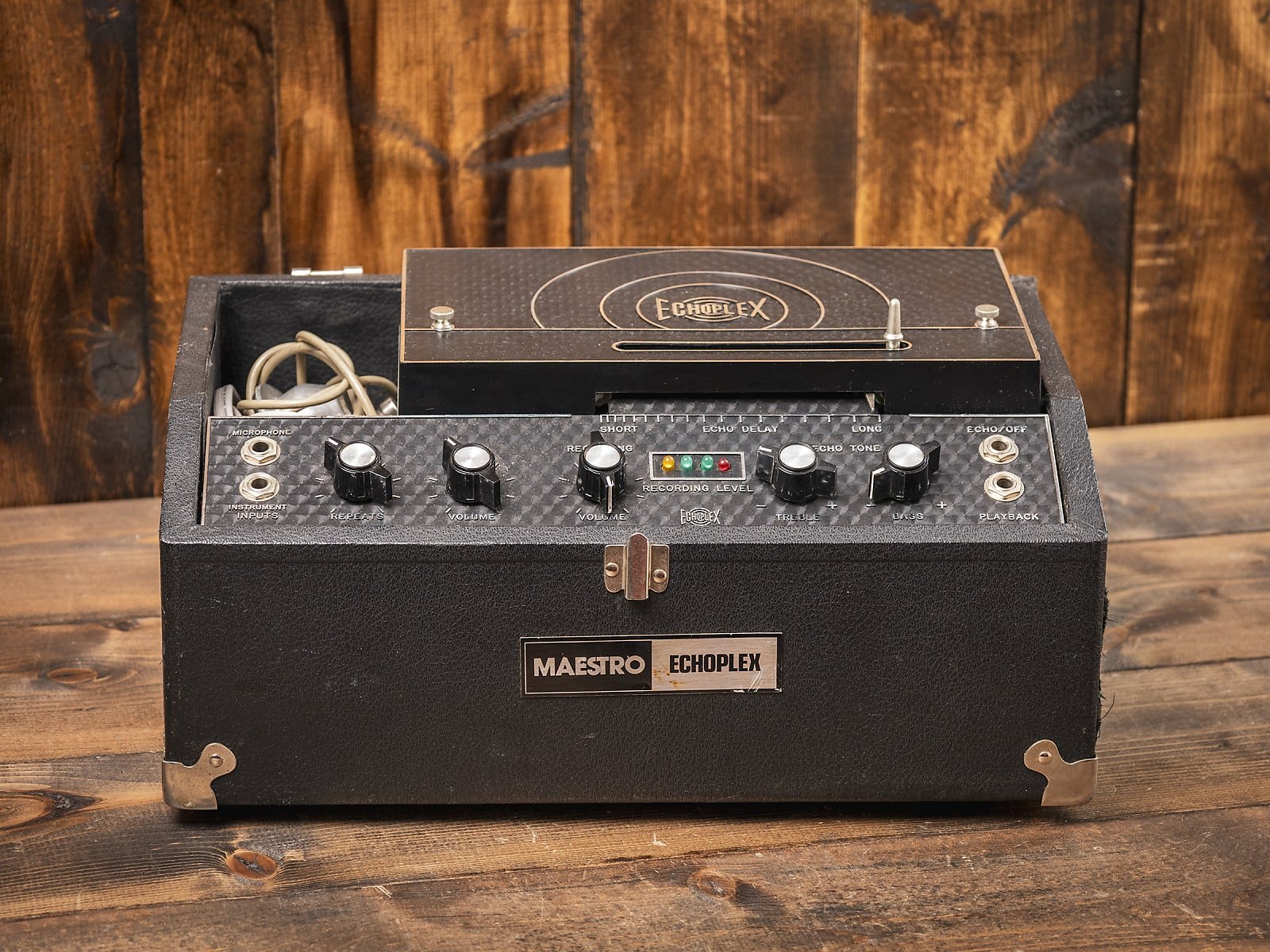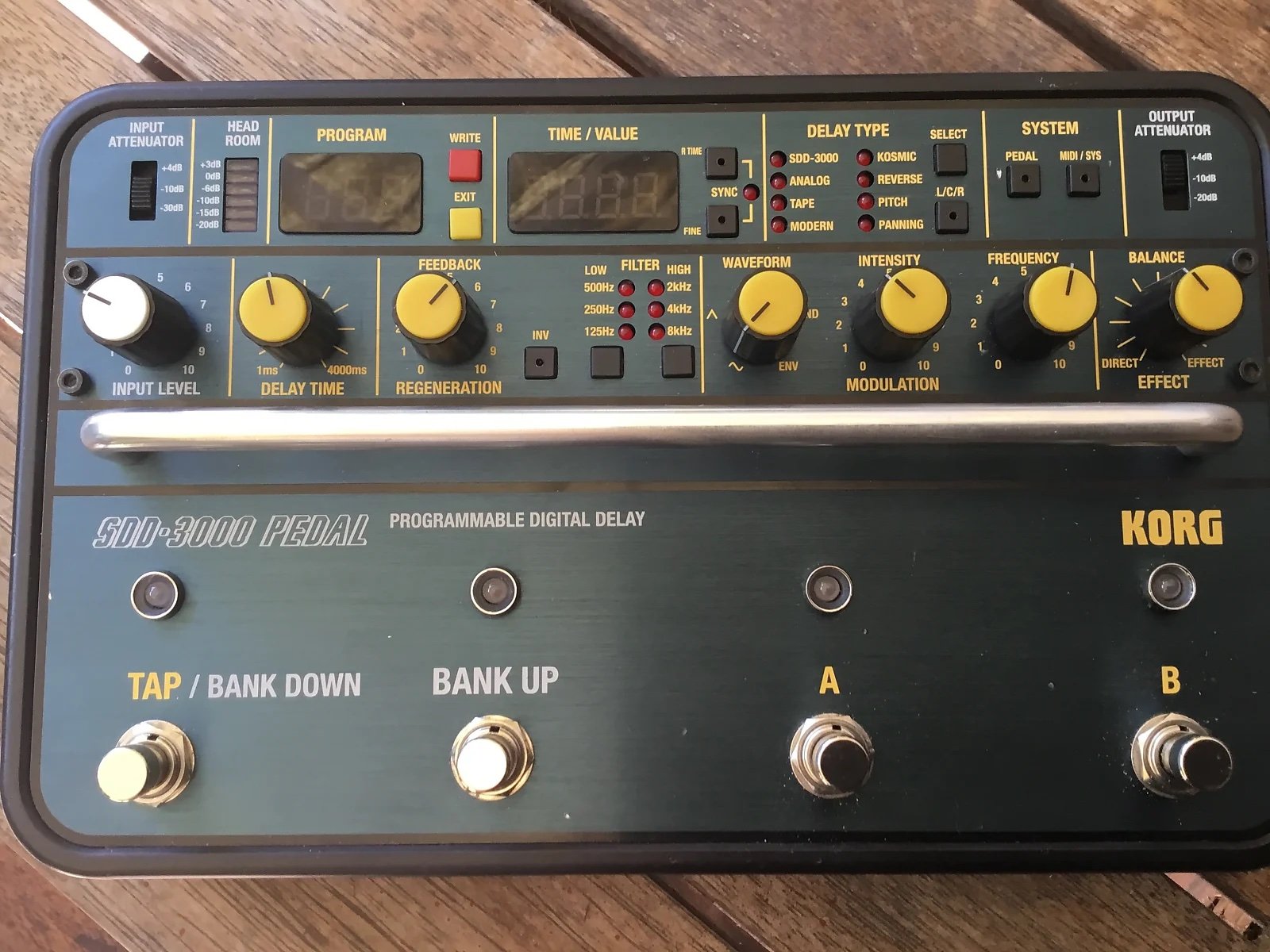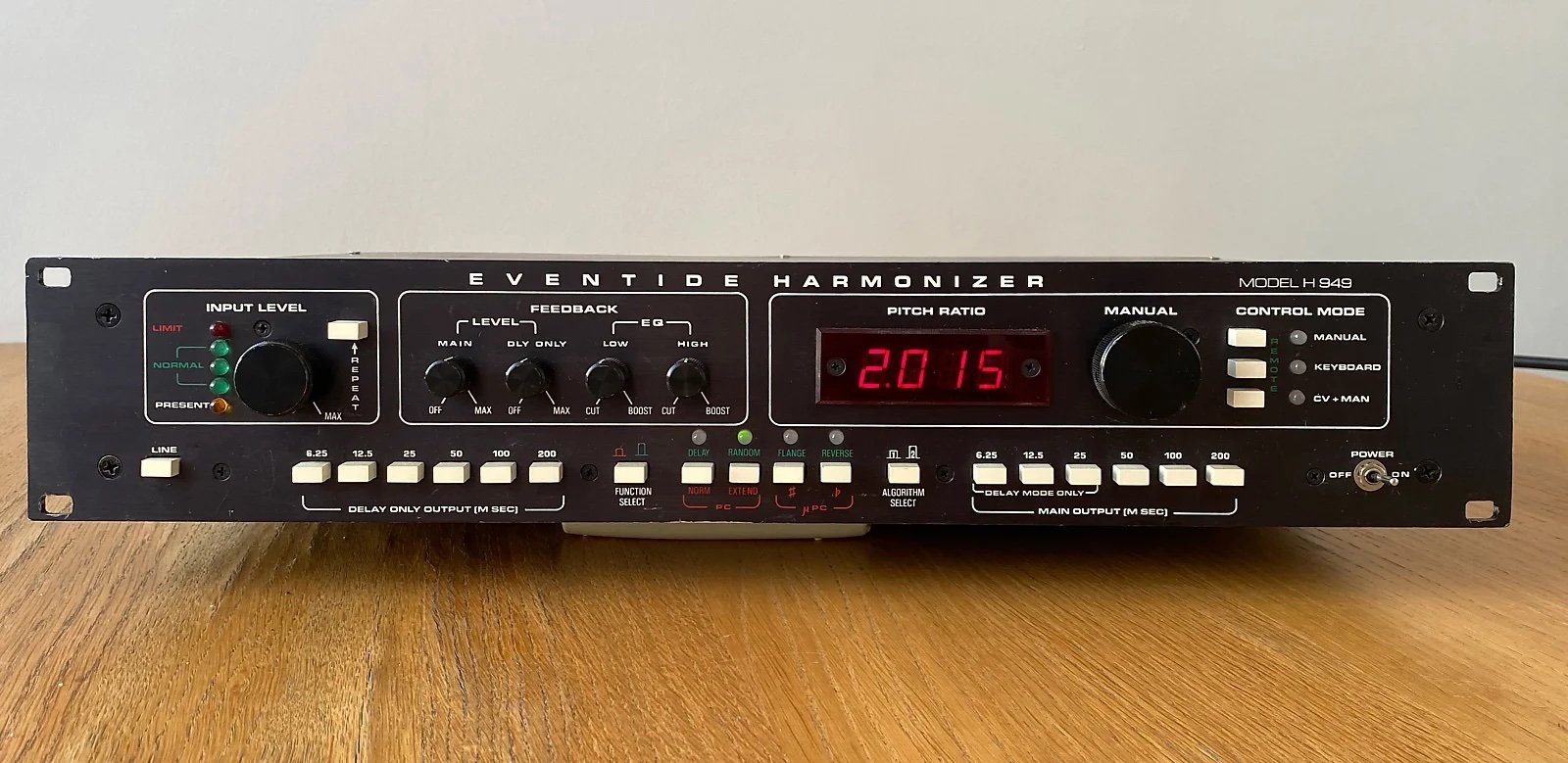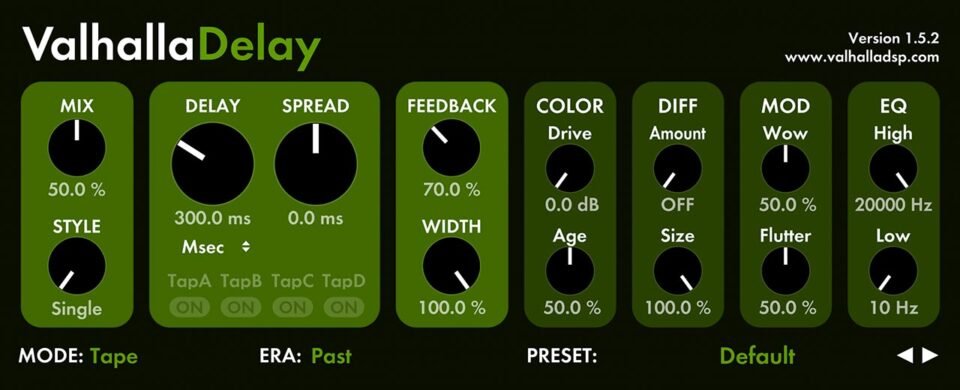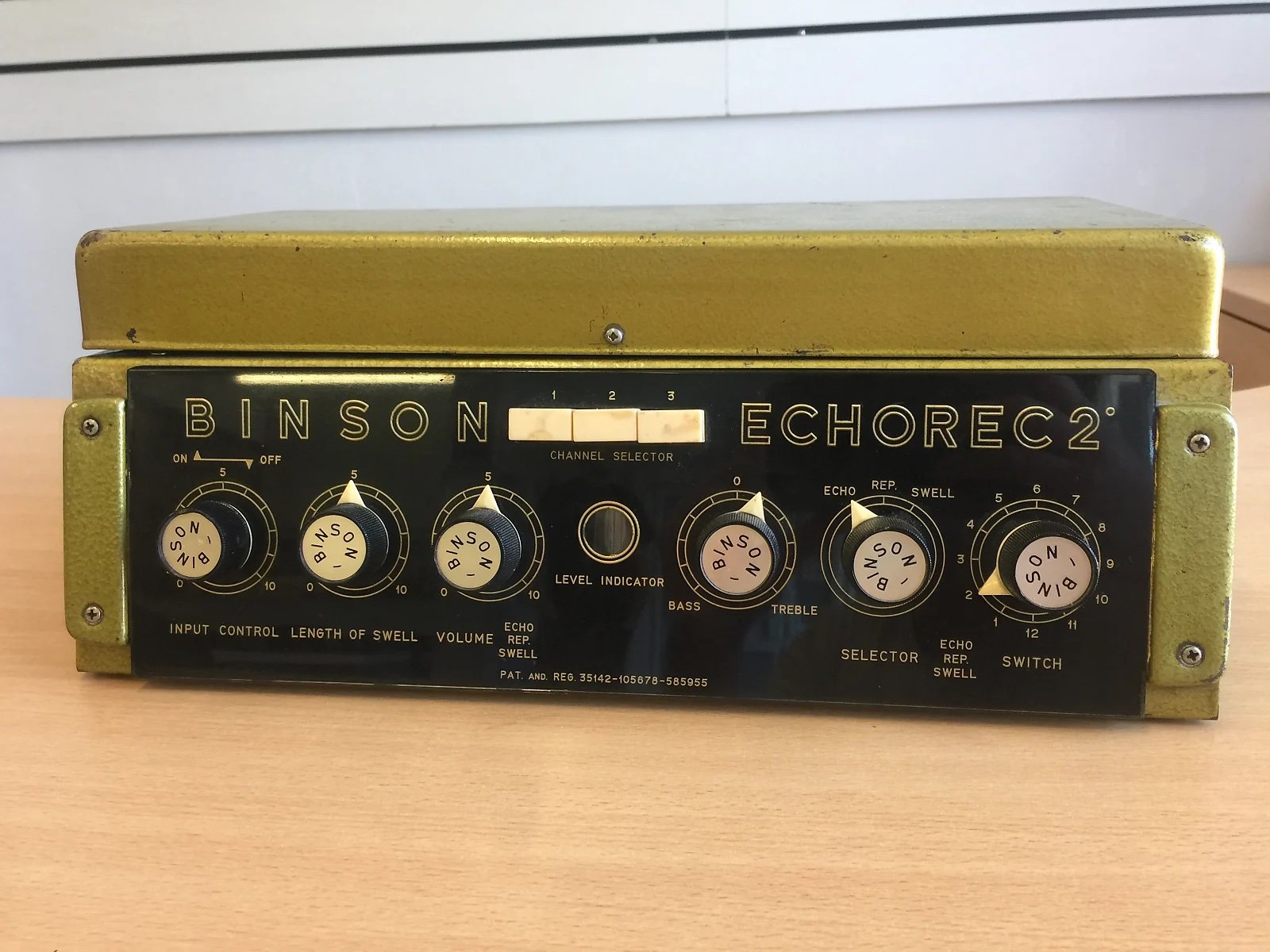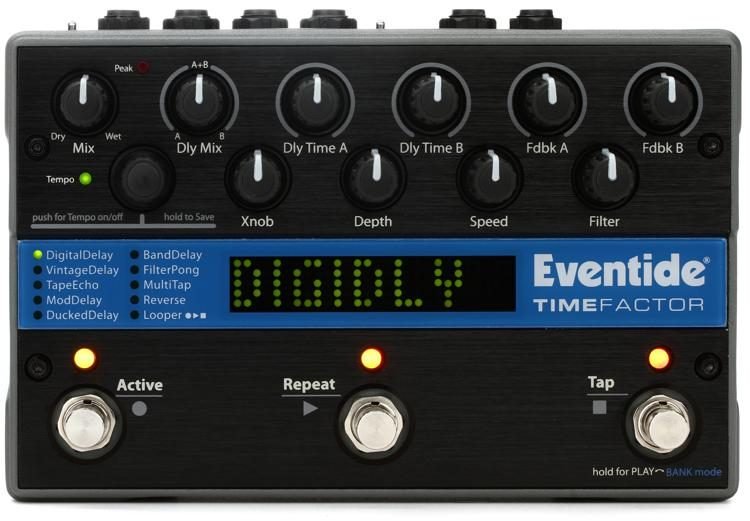A Brief but Complete Guide to Delay
The different colors of delay are significant when creating sounds. Each variety can significantly affect the tone of your guitar, synth, or vocal. Therefore, delay is not just a generic repeating device that I place in my signal chain. Instead, I consider distinguishing factors such as the tone of the repeats, the degeneration of the repeats, the tone of the preamp, the headroom, and other factors such as the size of the pedal and power requirements.
In this discussion, I will focus on different environments and how I pair delays for the occasion.
Studio
The studio usually has no restrictions on the size and power of delay units. For example, I have six delays connected to my rack in my studio.
One might ask, "why would I have six outboard delays?" I like to take advantage of the unique qualities of each delay.
Let's discuss some of the main types of delay:
Tape
Tape delay gets its name because delay/echo is created using a tape machine. The distance of the playback head from the record head determines the length of the delay.
There are several varieties of tape delay, such as solid-state and tube. My favorite is tube. The match of tape and tubes allows for repeats/echoes that are rich in harmonics and blend smoothly back in with the original sound.
Tape delay is not the style that creates an exact double of your sound. Instead, the repeats are "affected." Saturation, as well as wow and flutter (which is a lovely subtle chorus-like effect), are typical on tape echoes.
Tape echoes are large and won't fit on a pedalboard. They are also fragile and require maintenance. Therefore, only some people are going to lug one around to gigs. So, more often than not, you see real tape echoes in studios. Of course, I'm not speaking of tape echo emulations, but real tape echoes such as Ecoplex, Space Echo, and Fulltone Tube Tape Echo.
Tape echoes (especially with tubes) have a gooey and soft center that doesn't take over your tone or distract from the core sound. You hear a lead character, and the echoes are the supporting characters.
Analog Echoes
The early 1970s brought the invention of the IC Bucket Brigade Chip. This was a revolution for the guitar effects community. Along with analog delay, we would soon see analog chorus and flange.
The Electro Harmonix Memory Man is one of the most well-known early analog delays. Othe early analog delays would be the MXR delay and the Boss DM-1.
Early chips had limitations in the amount of information they could hold. Because of this, there can be a cool lo-fi sound to the repeats, which also loses high-end but in a different way than tape echo.
The repeats are more forceful than tape echo to my ears. Tape echo repeats tend to drop off quicker both in volume and EQ curve (fidelity). Analog echo repeats start to decompose after a certain amount of repeats, but they are a little tighter sounding with a unique grittiness.
One tip is if I'm using a bright source, such as a deluxe reverb guitar amp, I'll try to pair that bright source with a more mellow delay. In these situations, the last thing I usually want is a crystal-clear clean delay.
In my studio rack, I have a pair of analog delays, namely the Analog Man ARDX20 and the Electra EP 100. Although both are analog delays, they exhibit noticeable differences from one another.
The Analog Man is a high-quality, higher-fidelity, vintage-style bucket brigade analog echo. The Electra is a very lo-fi cheap analog echo that is super grainy. I use the Electra as a special effect.
The Analog Man offers two delay channels, allowing you to switch between two delay settings. All are adjustable with knobs and no submenus, which becomes essential when "playing" your delay as an instrument in realtime.
Digital Echoes
In the mid-1970s, digital delay was born. The 70s were quite a time for the evolution of guitar effects. The first digital delays were rack-mounted, and it took about ten years before digital delays started showing up in pedal form.
Some of these early rack unit digital delay units are still coveted today. The Eventide H910 harmonizer, the Korg SD-3000 are two classics. The Boss DD-2 was the first digital delay pedal.
The aim of designing digital delays was to create an exact replica of the input signal. Along with the ability to have exact sounding repeats, there was also the addition of longer delay times. Analog and tape delays can be spaced apart. Digital has opened up he ability for really long repeats.
With the digital advances, some may ask why you would ever bother with tape or analog echo. One criticism of digital echo is that it can sound sterile and cold. But some digital delay units still have character.
One of my preferred digital delays is the Korg SDD-3000, which part of early digital technology wasn't perfect, and I'm grateful for the distinct character in the tone.
The Korg SDD-3000, in particular, features a fantastic preamp that adds a flattering coloration to your signal. Its delays are remarkably clean but less sterile than in many contemporary digital delays.
Another unique early digital delay is the Lexicon Primetime, released in 1978. Primetime had the option for longer delay times, but achieving these longer delays would lower the fidelity of the delays. However, over time, musicians and engineers have come to love Primetime's specific lofi vibe with the delay multiplier circuit.
Due to the clearer repeats of digital echoes, each repeat stands out more than tape or analog delays. This property can be beneficial when working with heavily saturated sounds such as distorted guitars and thick synth pads.
In some cases, a synth can over-saturate an analog echo. Although this might be the desired effect, the lower headroom of analog echoes can make it stand out excessively. Additionally, analog echoes are more prominent in the midrange, which can either add or detract from the overall tone.
Considering the amp and guitar pairings, I experiment with various delays when working with guitars. I prefer using the Korg SDD-3000 or the Tape Echo for heavily distorted sounds rather than analog. On the other hand, I like Analog or tape with cleaner guitar sounds using Fender-style amps.
For synths, I typically opt for the Tape Echo for pre-1980s sounds or the SDD-3000 for Prophet/OB-6 sounds. Arp 2600 and modular-style synths pair exceptionally well with analog delays.
Emulation Central
While some decent emulations are available these days, they still need to catch up in some respects. As always, my advice is to make art in any way possible. If you can experiment with physical equipment, please do so. However, not having access to a diverse range of outboard gear doesn't mean you can't create exceptional music.
Using physical delays is an interactive experience. During a performance, I play my delays like an instrument in certain situations by twisting various knobs in real time. Real tape and analog delays have idiosyncratic behavior that can yield wonderful surprises. Imperfections in gear design can lead to beautiful musical moments that emulations can't replicate.
Additionally, there is a discernible tonal difference. However, that doesn't mean I rely solely on physical gear; I use a combination of Valhalla plugin delays and outboard delays when mixing. I choose to use both.
Valhalla sounds excellent and does the intended job, and it's beneficial in mixing when I don't require the distinctive quirks of actual echoes. Plus I find the user interface of Valhalla plugins to be very work friendly. The look is not cluttered or trying to be overly clever. I can get the sounds I want quickly.
Preamps
A preamp, short for "preamplifier," is an electronic device that amplifies a weak signal and prepares it for further processing. In the case of music equipment, preamps are commonly used to amplify the signal from a microphone or instrument, such as a guitar or bass, before it reaches other effects or recording equipment.
Preamps can significantly impact the tonal quality of an instrument or microphone. Some preamps are designed to add a specific character or color to the sound, while others are designed to be transparent and amplify the signal with minimal coloration.
Some delay units come with a built-in preamp that can be used independently of the delay effect to add volume to a signal, but it also colors the instrument's tone. This can be particularly useful for guitarists looking to add warmth or weight to their sound.
In addition to using preamps to color the tone, preamps can also be used to boost the signal level of an instrument, which can open up the tone and make it more dynamic.
This can be particularly useful for guitarists looking to push their guitar amplifier into overdrive or saturation, as it can provide a more dynamic and expressive sound.
Overall, preamps are essential to many music setups, and their unique characteristics can significantly impact the tonal quality of an instrument or microphone.
Live
Live performances present more challenges when choosing delays, as transportation and power can become significant factors to consider. Some questions that need to be answered include the size of the stage, the pedalboard, the power supply required for the pedals, the amp, and the means of transportation to the gig.
The tube tape echo and Korg SDD-3000 may sometimes be impractical, given their size and power requirements. For instance, fitting the tape echo onstage in NYC gigs, where space is limited, can be challenging. Smaller delays like the Analog Man ARDX20 and Strymon El Capistan are preferred in such cases. The latter is a tape delay emulation pedal with unique qualities that set it apart from other emulation pedals, such as a hidden spring reverb sound and a unique wow and flutter.
Some questions to ask when searching for the right echo include whether one needs a delay with its identity or character, space, power, budget limitations.
Multi-Tap Delays
A multi-tap delay is an effect that creates multiple echoes of the original signal at different time intervals. "multi-tap" refers to tapping into various points of the delayed signal and adding additional delays or taps. This allows for more complex and rhythmic delay patterns to be created and the ability to make echoes that sound like they are bouncing around a room. Multi-tap delays can be found in magnetic drum echos and digital delay pedals and can be used in various musical genres.
One of the earliest multi-tap delays was the Binson Echorec which, aside from having multi-taps, was the best-sounding delay ever built in my opinion.
The Binson Echorec was a magnetic drum echo device that used a spinning magnetic drum to create its delay effect. It was invented in Italy in the late 1950s.
The problem is that there are currently no true Echorecs in production, and the pedal versions and plugin emulations just don't come close to my ears.
The Binson Echorec preamp added a very special character to your sound. The Echorec multi-taps could create quite interesting ambient and reverb-like sounds as well.
There are other more modern options of multi-tap delays are your thing. The Strymon Timeline comes to mind as well as the Eventide Time Factor. These are not Echorec emulations but rather digital multi-tap delays.
Reverb as Delay
This article wouldn't be complete if I didn't discuss using reverb as a delay. Adjusting the predelay on a reverb unit can create exciting delay and slapback effects.
The pre-delay on a reverb refers to a time delay between the original sound source and the start of the reverberation effect. Essentially, it determines the time between when the direct sound hits the listener's ears and when the reverb tail begins.
While predelay can be used to create a sense of space, it is less effective in creating multiple repeats than a delay. Predelay refers to the time between the original sound and the onset of the early reflections in a reverb effect and adjusting it can create a sense of distance between the source and the listener.
I use a Chase Bliss Audio CXM 1978 to experiment with reverb as a slap. Aside from the CXM 1978 sounding exceptional, I also like the realtime accessibility to adjusting the parameters such as, you guessed it, predelay!
Feedback Loop
An often overlooked feature of delay is the behavior of the feedback knob. The feedback knob adjusts how many repeats occur. Anywhere from one single repeat with the knob down to full-on oscillation with infinite repeats with the knob up. What varies from delay to delay is not whether they can make soundscapes with washed-out repeats, but how the volume of the repeats reacts.
On some delays, such as tape delay, the repeats will raise in volume as they stack on top of each other, which sometimes can get out of control if you're not manipulating the mix knob in connection.
Analog delays allow the repeats to sit in a consistent volume bed that doesn't take over your sound. There are times when the volume increases with infinite repeats on a tape echo can be problematic. Other times the volume increases can be sonically interesting as it will push everything harder in your signal chain, causing more saturation.
I also chose a delay for a specific sound based on the reaction of the feedback knob. Therefore, it's worth investigating the feedback knob of a delay unit to find out what works best for your application.
Tap Dancer
Many modern delays have the option for tap tempo, allowing you to tap in the song's tempo to sync the delay. Unfortunately, this tap feature wasn't available on many classic delays. But is this a bad thing? Not necessarily. I think there is a misperception these days that delays should be perfectly synced to a song.
Syncing tempo is not a right and wrong issue, however. The advantage to syncing delays is they lock into the rhythm perfectly. The disadvantage to perfectly syncing delays is you can lose the sound of the delys because they blend in too perfectly.
There are a lot of times when I like the delay to be heard a little more, and the fact that it's not 100% perfectly in time with the tempo allows it to pop out a little. So, like many of the aspects of delay I've been talking about, it's situation dependent.
I hope you found this article helpful in understanding the wide delay varieties. I encourage you to experiment and hear what delay suits your tastes and needs best.


